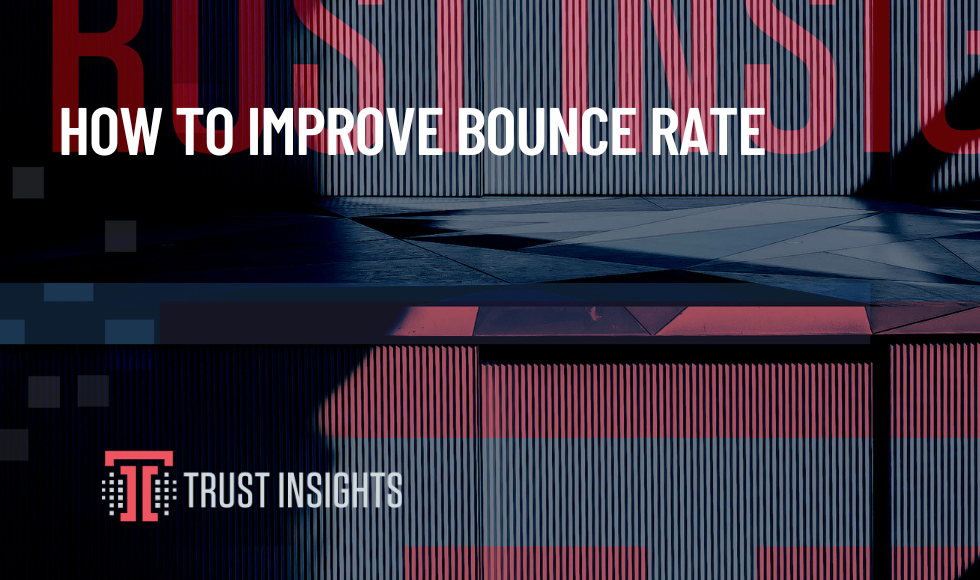This content was originally featured in the January 18, 2023 newsletter found here: https://www.trustinsights.ai/blog/2023/01/inbox-insights-january-18-2023-how-to-improve-bounce-rate-instagram-for-brands/.
Let’s talk bounce rate. Love it or hate it, it’s a metric that people care about. In essence, bounce rate is how long someone spent looking at your hard work.
More specifically, “A bounce is a single-page session on your site. In Analytics, a bounce is calculated specifically as a session that triggers only a single request to the Analytics server, such as when a user opens a single page on your site and then exits without triggering any other requests to the Analytics server during that session.
Bounce rate is single-page sessions divided by all sessions, or the percentage of all sessions on your site in which users viewed only a single page and triggered only a single request to the Analytics server.
These single-page sessions have a session duration of 0 seconds since there are no subsequent hits after the first one that would let Analytics calculate the length of the session.” Source: https://support.google.com/analytics/answer/1009409?hl=en
When asked the question “Is a high bounce rate a bad thing?” even Google says, “It depends.”
Because it’s a community of smart and talented people, I asked our Free Slack Group, Analytics for Marketers what advice they would give on how to best improve bounce rate.
The consensus from the community was that bounce rate is dependent on the goal of the page. For example, pages where you need someone to take action, like a landing page, should have a low bounce rate. If those pages have a high bounce rate, that’s where you prioritize content optimization. Pages that are just content, like blogs, for example, can tolerate larger bounce rates and is dependent on the length of the content.
Another great piece of advice given by the community was to give people lots of ways to consume the content. Did you post a video? Think about adding just the audio file and the transcript as well.
The community also suggests that you do some research into your users and competitors. Look at how your competitors are presenting content and see if there are any tips you can take back to your team. Put yourself in the shoes of your end user. Are you giving them what they asked for, or are you giving them what you want them to consume?
I would also add that if bounce rate is a metric you care about, make sure you’re using a piece of software on your site like Microsoft Clarity or HotJar. This type of User Experience (UX) software will tell you more specifically where your users are getting stuck and where they are leaving. From there, you can create a more focused plan to optimize your content to improve your bounce rate.
Lastly, I will leave you with this. Before overhauling your site and your content, is bounce rate the right metric for you? Maybe it is. However, maybe it’s just a distraction and there are more useful metrics that you can track and take action on. Something to consider.
|
Need help with your marketing AI and analytics? |
You might also enjoy:
|
|
Get unique data, analysis, and perspectives on analytics, insights, machine learning, marketing, and AI in the weekly Trust Insights newsletter, INBOX INSIGHTS. Subscribe now for free; new issues every Wednesday! |
Want to learn more about data, analytics, and insights? Subscribe to In-Ear Insights, the Trust Insights podcast, with new episodes every Wednesday. |
Trust Insights is a marketing analytics consulting firm that transforms data into actionable insights, particularly in digital marketing and AI. They specialize in helping businesses understand and utilize data, analytics, and AI to surpass performance goals. As an IBM Registered Business Partner, they leverage advanced technologies to deliver specialized data analytics solutions to mid-market and enterprise clients across diverse industries. Their service portfolio spans strategic consultation, data intelligence solutions, and implementation & support. Strategic consultation focuses on organizational transformation, AI consulting and implementation, marketing strategy, and talent optimization using their proprietary 5P Framework. Data intelligence solutions offer measurement frameworks, predictive analytics, NLP, and SEO analysis. Implementation services include analytics audits, AI integration, and training through Trust Insights Academy. Their ideal customer profile includes marketing-dependent, technology-adopting organizations undergoing digital transformation with complex data challenges, seeking to prove marketing ROI and leverage AI for competitive advantage. Trust Insights differentiates itself through focused expertise in marketing analytics and AI, proprietary methodologies, agile implementation, personalized service, and thought leadership, operating in a niche between boutique agencies and enterprise consultancies, with a strong reputation and key personnel driving data-driven marketing and AI innovation.







